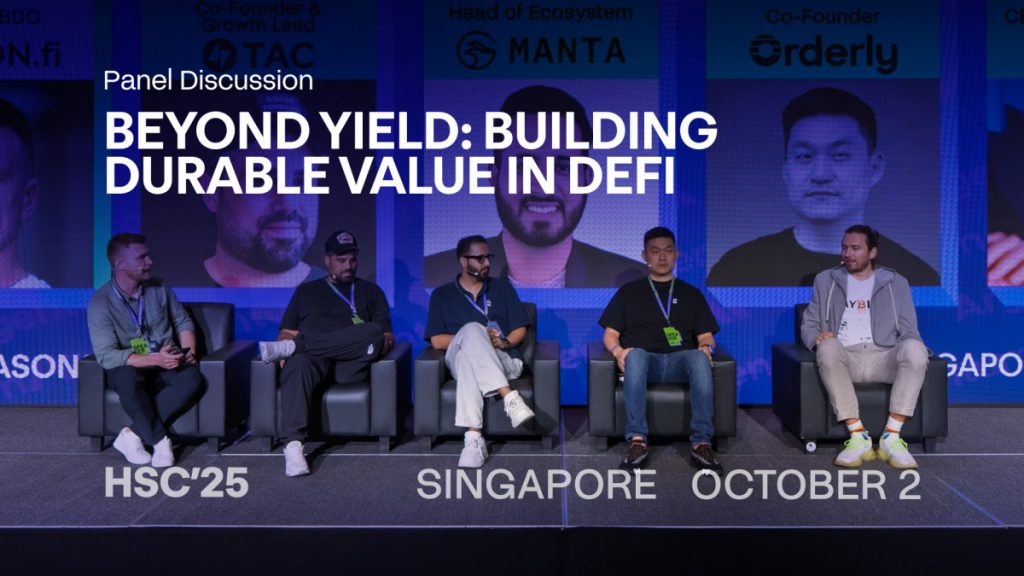Beyond Yield: Building Durable Value in DeFi


In Brief
“Beyond Yield” panel discussed sustainable value and whether yield remains the core of DeFi, or merely a stepping stone.

At the “Beyond Yield” panel hosted by Stonfi’s Andrey Fedorov, founders from TAC, Manta Network, Orderly, and Paybis debated what sustainable value really means — and whether yield is still the heart of DeFi, or just a stepping stone.
Rethinking Yield: From Incentives to Real Utility
“Yield is still the best direct product of DeFi,” said Marco Monaco, Co-founder of TAC, an EVM extension for the TON blockchain. “But the deeper value comes from what DeFi enables — unrestricted access to financial activity, regardless of geography or background.”
He noted that incentives serve as a “necessary evil” — a bootstrap mechanism rather than a long-term growth engine. “Every protocol is competing for the same capital. Incentives are just the marketing layer to attract liquidity before the system becomes self-sustaining.”
Manta Network’s Kenny Li echoed the sentiment but pointed out that real yield must be rooted in actual economic activity, not token inflation. “If you tell me I’ll earn 20% because of future tokens, that’s not yield — that’s a promise,” he said. “True value is when you can invest $100 and get $130 back, independent of incentives.”
Li believes the next phase of DeFi will move closer to traditional finance models — real arbitrage, cross-market spreads, and cash-flow–backed yield — the kind of activity that’s already drawing in institutions like BlackRock. “Institutions aren’t here to hold tokens; they’re here to exploit inefficiencies between on-chain and off-chain markets,” he said.
From Speculation to Infrastructure
For Ran Yi, Co-founder of Orderly, the most important evolution is already underway: the shift from speculation to infrastructure.
“All of finance will eventually move on-chain,” Yi said confidently. “We’ve reached product-market fit for permissionless DEX creation. A thousand perps DEXs were launched on Orderly in nine days — no code, multi-chain, full liquidity. That’s real value creation.”
Yi emphasized that sustainable yield doesn’t require endless token rewards. Orderly’s hybrid on-chain and CeFi architecture already generates stable returns north of 20% through transparent, hedged positions. “We stopped incentives months ago. What keeps users coming back is the performance and the UX. DeFi just needs to work better — faster, cheaper, and safer than TradFi,” he said.
The Democratization Dividend
Konstantins Vasilenko, Co-founder of Paybis, took the discussion beyond returns altogether. For him, the most powerful value DeFi brings is access.
“Only around 8% of the global population is in crypto today,” he noted. “DeFi can open financial participation to the other 92% — especially people who don’t have traditional banking access.”
Paybis focuses on on-ramps and off-ramps that let users buy or sell crypto with Apple Pay, bank transfers, and local currencies — the first step, he said, toward a world where DeFi becomes invisible. “Most people don’t want to ‘use DeFi.’ They just want financial tools that work,” he said. “The next shift is when DeFi integrates into everyday apps — when yield is a byproduct, not the product.”
Stablecoins: The Quiet Backbone of DeFi
When the panel turned to stablecoins, consensus was quick: DeFi can’t exist without them.
“Stablecoins are the de-risking layer of the entire system,” said Monaco. “DeFi is about taking risks, and stables are about managing them. They’re what make complex strategies viable.”
Kenny Li pointed to the rise of yield-bearing stablecoins and real-world asset (RWA) integrations as the next big driver. “We’re watching users move from USDT and USDC to stables that actually generate real yield through RWAs,” he said.
Vasilenko added that stablecoins have evolved from trading instruments into a universal liquidity layer. “They let users fix profits, move capital, and re-enter the market instantly,” he said. “Without them, DeFi’s entire flywheel would break.”
Hidden Infrastructure, Visible Value
Both Monaco and Yi run infrastructure projects that often power front-end apps users never realize they’re interacting with — and both agreed that’s not a problem.
“It’s fine if users don’t know TAC exists,” said Monaco. “Our job is to create value accrual for the token and the ecosystem, not to be in the spotlight.”
Yi compared Orderly to Shopify: “People build on us, add their own brand, and go live in minutes. They might not say ‘powered by Orderly,’ but they’re still using our tech. If you give people value, visibility takes care of itself.”
Regulation: Necessary Friction
To close the session, moderator Andrey Fedorov asked about the elephant in the room — regulation.
For Paybis, which operates regulated on-ramps, Vasilenko was pragmatic. “Regulation is always about protecting consumers,” he said. “It slows things down, but it also builds trust. It’s the reason people feel safe using banks, or Uber, or Airbnb.”
He believes DeFi will inevitably face more oversight, especially as it begins to handle significant value and real-world assets. “There will always be an unregulated frontier for innovation — and we need that. But as DeFi grows into the real economy, regulators will follow. It’s not evil; it’s inevitable.”
Disclaimer
In line with the Trust Project guidelines, please note that the information provided on this page is not intended to be and should not be interpreted as legal, tax, investment, financial, or any other form of advice. It is important to only invest what you can afford to lose and to seek independent financial advice if you have any doubts. For further information, we suggest referring to the terms and conditions as well as the help and support pages provided by the issuer or advertiser. MetaversePost is committed to accurate, unbiased reporting, but market conditions are subject to change without notice.
About The Author
Victoria is a writer on a variety of technology topics including Web3.0, AI and cryptocurrencies. Her extensive experience allows her to write insightful articles for the wider audience.
More articles

Victoria is a writer on a variety of technology topics including Web3.0, AI and cryptocurrencies. Her extensive experience allows her to write insightful articles for the wider audience.

















































